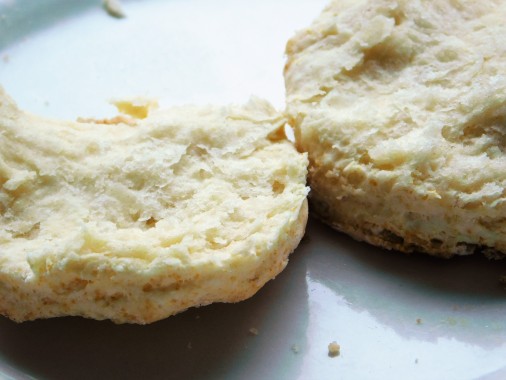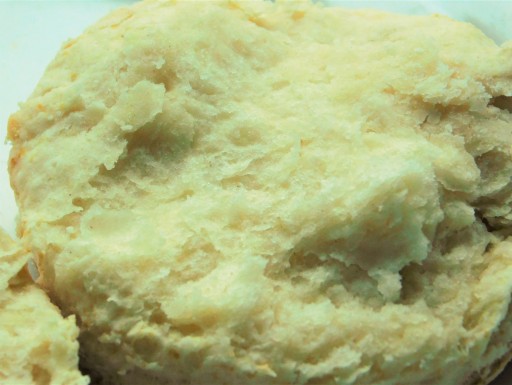When did my love affair with biscuits begin? It’s hard to say with so many food memories being tied up with them. They are the perfect cradle for sausage gravy with extra black pepper. There is nothing quite like a hot biscuit with homemade jam (except maybe the heel end of a fresh loaf of bread with homemade jam). They can top potpie elegantly. They can be lightly sweetened and used as a topper for fruit cobbler. They can be When done right, they are hard to beat, but they are so often done wrong. (Think flavorless hockey pucks). I know, I know, people ask why they should bother making their own biscuits since there are products out there like Bisquick (which I used in Breakfast Pie, Quick Cinnamon Rolls) and cans of biscuits (Supper In a Bread Loaf), but trust me, homemade biscuits are just so much better. The process of making them doesn’t take that much longer than using something premixed. 
The recipe, as published, has a very good description of the basic method of biscuit making, however, it’s not the way I do it any more. I’ve read about method in Cook’s Illustrated magazine. I’ve read about method in various southern cookbooks. I’ve watched people make biscuits in different kitchens. After trying out various options, I’ve settled on two that I like and are my go-tos. Two? Yes. You see, I needed an option that used my hands for the days where I just need to get my hands dirty and really want to make perfect biscuits, but I needed another option for the days where I just can’t deal and want to hurry up. Both ways make great biscuits, but the hands-on method really helps me adjust everything until it feels just right.
Ok, so for the hands-on method, you put the fat (shortening, in this recipe, but otherwise butter quartered the long way and then cut into smaller cubes using a bench knife) and the flour, salt and leavening ingredients into a large bowl. Using clean hands, (because apparently I think you don’t know to wash your hands before cooking food??) Put your hands into the ingredients and start smooshing and flattening the fat between your fingertips. I like to sort of use the “cash rub”. You know the thing people do in the movies when they are saying something is spendy or they are asking for cash. This is not to be confused with “Making it rain” because you don’t want that mess in your kitchen. By lifting your hands above the bowl and letting everything fall back into the bowl, it keeps the fat cool. Once the shortening and dry ingredients are all nice and incorporated (I like to leave some chunks slightly larger than others because it makes the biscuits more interesting), add the milk. Unless you are planning on making drop biscuits, do not add too much milk. With your fingers (which are quickly resembling monster hands at this point) fold the milk into the dry ingredients. It should just take a couple of passes around the bowl and the milk will be absorbed. Even if you don’t think the dry ingredients have been incorporated enough at this point, dump the whole mess onto a floured countertop. Lightly knead the biscuit dough about 10 times. At this point the rest of the dry ingredients should be incorporated and your dough should be just vaguely sticky. I never use a rolling pin to help shape my biscuits. I just pat it down into about the thickness I want and then cut from there. Straight onto an ungreased cookie sheet and into the oven. The bench knife I mentioned earlier comes in handy at this point to clean off your counter. It also is useful if you haven’t floured your counter well enough and need a tool to keep your biscuit dough from sticking.
When I don’t want to get my hands dirty, I follow the same process almost exactly, but dump all the ingredients except the milk into the food processor (I got that thing in college and it’s still a workhorse) and pulse it until it looks like coarse crumbs (or that crappy kinetic sand stuff that is impossible to clean). At that point, I add the milk, pulse until mostly incorporated and dump the mess on my counter. From that point on, it’s exactly the same process as above.
Now, this recipe specifically? It’s not my favorite biscuit recipe. It’s a perfectly good basic biscuit, but it’s not complex or deep. It lacks the lightness and tang from buttermilk. They aren’t the same sort of flaky and moist that you get from using butter. No one at my house was complaining about these, but it’s rare that anyone complains about bread fresh from the oven. 
I know what you are really asking yourself at this point. What did we do with these biscuits? Did we slather them with butter? Did I top them with homemade apple butter or Apple Marmalade? Nope. We topped these biscuits with bacon gravy and ate them for breakfast.



0 comments on “Extra Special Biscuits (for an unspecial occasion)”Add yours →